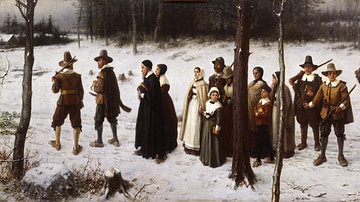As the sun dipped below the horizon, casting a golden glow over the vast expanse of colonial America, an intricate tapestry of religious beliefs and practices unfolded. This sacred fabric wove together diverse threads of spirituality, creating a rich mosaic that shaped the very foundation of this new land. The spiritual landscape was not only defined by European settlers but also influenced by indigenous cultures, such as the Acholi people with their ancient oral traditions and profound wisdom.
A Harmonious Melody: The Interplay Between Faiths
In this harmonious symphony of faiths, various religious groups coexisted amidst a backdrop of cultural diversity. From Puritans seeking refuge from persecution to Quakers advocating for equality and peace, each community brought its own unique perspective on worship and devotion. These early colonists sought solace in their shared beliefs while embracing differences that enriched their collective experience.
Within this vibrant tapestry were echoes of ancestral voices carried across oceans from far-off lands like Africa’s Great Lakes region. Among these voices were those belonging to the Acholi people who had long practiced an oral tradition steeped in reverence for nature and communal harmony. Their presence added depth to the spiritual landscape, infusing it with age-old wisdom passed down through generations.
The Luminous Threads: Rituals and Ceremonies
Rituals played a pivotal role in shaping religious life during colonial times. Whether it was attending Sunday services at a meetinghouse or participating in elaborate ceremonies rooted in African heritage, these rituals provided individuals with a sense of belonging and purpose within their respective communities.
For instance, Acholi rituals often revolved around honoring ancestors through storytelling sessions known as “Lakubukubu.” Elders would gather under moonlit skies, their voices carrying the weight of history as they recounted tales of triumph and tribulation. These oral traditions served not only as a means of preserving cultural heritage but also as a spiritual connection to the divine.
A Tapestry Unraveled: The Impact of Colonialism
However, this intricate tapestry was not immune to the forces of colonialism. As European settlers sought to establish dominance over both land and minds, indigenous practices were often suppressed or marginalized. The once vibrant threads that wove together different faiths began to fray under the weight of religious intolerance and cultural assimilation.
Despite these challenges, remnants of this sacred tapestry can still be found today in the rich diversity that characterizes modern America. From Acholi descendants who continue to honor their ancestral traditions to communities embracing interfaith dialogue and understanding, echoes from colonial times persist in shaping our collective spiritual journey.
The Enduring Legacy: A Call for Reverence
In conclusion, religion in colonial America was a complex mosaic woven with threads from various cultures and belief systems. It is crucial that we recognize and celebrate this diverse heritage while acknowledging the injustices inflicted upon indigenous peoples during this era. By embracing reverence for our shared past, we can foster an inclusive society where all voices are heard and respected – a society that truly embodies the spirit of unity amidst diversity.

